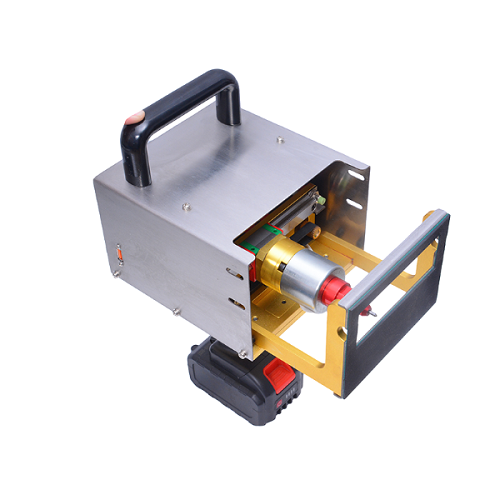The Benefits of Handheld Marking Machines for Industrial Applications
2025-03-25
In the fast-paced world of modern manufacturing, efficiency and accuracy are essential. One of the key tools that help improve both is the handheld marking machine. These versatile devices have become invaluable in various industries, offering a reliable solution for labeling, engraving, and marking materials. Whether it's for product identification, traceability, or part numbers, handheld marking machines are essential for businesses that require precision and speed.
What is a Handheld Marking Machine?
A handheld marking machine is a portable device used to engrave or mark various materials such as metal, plastic, wood, or ceramics. Unlike traditional marking methods, handheld machines offer flexibility and mobility, allowing operators to mark items directly on the production floor or in hard-to-reach locations. These machines are typically powered by either electric or pneumatic sources and are designed to provide clear, permanent markings that withstand wear and tear.
Handheld marking machines come in various types, including dot peen, laser, and ink-based systems, each suited to specific marking requirements. Dot peen machines use a stylus to create small dots that form a pattern or text, while laser marking machines use concentrated beams of light to etch permanent markings onto surfaces. Ink-based systems rely on high-quality ink to print text, logos, or barcodes on surfaces.
Advantages of Handheld Marking Machines
1. Portability and Convenience
One of the main advantages of handheld marking machines is their portability. Their lightweight and compact design allow them to be easily carried around the shop floor, making it easier for workers to mark items directly where they are located. This eliminates the need for transporting materials to a separate marking station, saving valuable time and resources.
2. Flexibility in Application
Handheld marking machines can mark a wide variety of materials and surfaces, from metals like steel and aluminum to softer materials like plastic and wood. This versatility makes them ideal for industries such as automotive, aerospace, construction, and manufacturing, where different types of materials need to be marked for identification, branding, or safety purposes.
3. Increased Accuracy and Precision
Traditional marking methods such as hand stamping or using stencils can often result in inconsistent or imprecise markings. Handheld marking machines, on the other hand, offer high precision, ensuring that every marking is clear, accurate, and permanent. Whether it's a serial number, product code, or logo, these machines ensure that the marking is legible and of high quality.
4. Reduced Labor Costs
The speed and efficiency of handheld marking machines can significantly reduce labor costs. With faster processing times compared to manual methods, businesses can achieve higher throughput with fewer workers. Additionally, the reduced likelihood of human error translates into fewer mistakes, reducing the need for rework or corrections.
5. Durability and Permanence
Handheld marking machines are designed to create permanent markings that are resistant to wear, fading, or damage. This is particularly important for industries where traceability and product identification are critical. Whether it's in harsh industrial environments or exposed to chemicals and weathering, the markings made by these machines are durable and can last the lifetime of the product.
6. Ease of Use
Most handheld marking machines are designed to be user-friendly, with intuitive controls and minimal training required. Operators can quickly learn how to use the device, allowing for a faster integration into the production process. Many models also offer adjustable settings, enabling users to customize the marking process to meet their specific needs.
Applications of Handheld Marking Machines
Handheld marking machines are used in a variety of industries, including:
1. Automotive Industry
In the automotive industry, handheld marking machines are used to mark parts with serial numbers, barcodes, and other identification information. These markings help with inventory tracking, quality control, and product recalls. They are also used for engraving part numbers on engine components, chassis, and other vital pieces of equipment.
2. Manufacturing and Fabrication
Manufacturers use handheld marking machines to label and mark items in the production process. These machines can mark product codes, specifications, or company logos on a wide range of materials, ensuring that each product can be traced throughout its lifecycle. The flexibility of handheld devices makes them suitable for use on everything from small parts to large industrial equipment.
3. Aerospace and Aviation
Aerospace components require precise and clear markings for identification, inspection, and safety purposes. Handheld marking machines are ideal for engraving part numbers, batch codes, and safety instructions on critical parts, ensuring that they comply with regulatory standards and are easily traceable.
4. Construction and Heavy Equipment
In the construction industry, handheld marking machines are used to mark tools, equipment, and materials with identifying information, reducing the risk of theft and ensuring accountability. Whether marking steel beams or machinery, these machines help contractors and builders keep track of their assets.
5. Electronics
The electronics industry relies on handheld marking machines to label components with serial numbers, model identifiers, or logos. These markings are important for both manufacturing and warranty purposes, allowing for easy identification and traceability in the event of defects or recalls.
Choosing the Right Handheld Marking Machine
When selecting a handheld marking machine, it's essential to consider factors such as the material being marked, the type of marking required (text, logos, serial numbers, etc.), and the operating environment. For example, a dot peen machine may be suitable for metal components, while a laser marking machine may be better for more delicate materials or precise designs.
It's also important to evaluate the machine’s ease of use, portability, and maintenance requirements. Some machines may offer additional features, such as customizable marking depths or the ability to store multiple marking templates for faster use.
Conclusion
Handheld marking machines are an indispensable tool in many industries, offering a portable, efficient, and cost-effective solution for creating permanent, high-quality markings. With their versatility, accuracy, and ability to withstand harsh environments, these machines help improve product traceability, enhance safety, and streamline production processes. As industries continue to demand higher efficiency and precision, handheld marking machines will remain an essential tool in the world of manufacturing and beyond.



